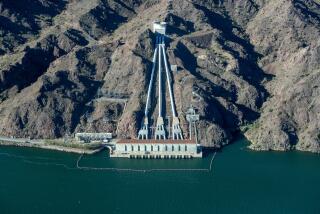Op-Ed: Fixing the imbalance in access to water
Last fall, farmers working the flat land along the Colorado River outside Blythe, Calif., harvested a lucrative crop of oranges, lettuce and alfalfa from fields irrigated with river water. But that wasn’t their only source of income. They made almost as much per acre from the seemingly dead squares of dry earth abutting those orchards and row crops, fields left barren for the season.
The money crop that the fallowed land produced was one of the West’s most precious commodities: water. Under an experimental trading scheme set up by the Palo Verde Irrigation District in Blythe and the Metropolitan Water District — which supplies municipal water to the Los Angeles area, Orange and San Diego counties, and much of the Inland Empire — the farmers essentially leased millions of gallons of their Colorado River water to California’s coastal cities.
It’s a prototype of a trade that may soon become much more common, and the kind of win-win scenario that could help solve the West’s water crisis.
The Colorado River basin — which provides water to California, Arizona, New Mexico, Nevada, Colorado, Utah and Wyoming — is entering its 16th year of drought. The nation’s largest reservoir, Lake Mead, is nearly two thirds empty, in large part because even in wet years those seven states take more water from the river than the Colorado, on average over the last century, has provided.
This overuse — coupled with arcane laws discouraging conservation, subsidies encouraging profligate water management and political gamesmanship — has helped make the West’s water desperately scarce and left its governments unprepared for a changing climate. ProPublica has reported extensively on these failures in its five-part series “Killing the Colorado.”
But, as experts such as former Arizona Gov. and Interior Secretary Bruce Babbitt point out, there is, in fact, a great deal of water available in the Colorado River basin. There is just a gross imbalance — institutionalized through law and policy and tradition — in who has access to it.
At the core lies a fundamental tension between agriculture, which uses about 80% of Colorado River water, and the watershed’s growing cities, which desperately want to use more of it. Both present convincing claims: Colorado River-irrigated agriculture — including lands in Southern California — provides about 15% of the nation’s food supply; meanwhile, cities such as Las Vegas, Phoenix and L.A. want to continue to grow in order to remain vibrant and serve their millions of residents, who drive the region’s other economies.
This standoff has long shadowed development in the West. It stirs up divisive politics, a fight generally couched in terms of which water user is more important, more deserving and more responsible in its stewardship of a scarce natural resource — agrarian food growers or the urban pioneers of new economies.
But debating whether farms or cities are “more deserving” ignores a simple fact embedded in the foundation of law governing the West and its water: Though most water is technically a public asset, the right to use it was long ago promised to individuals and is virtually irreversible, so long as the water is put to good use. Those rights are viewed by many as inviolable private property rights.
Farms — many of which were granted their water rights 100 years ago — believe they earned them, through more than a century of pioneering and risk they shouldered to settle and build the growing regions that now covet their water. And in most cases, the courts and state governments of the Colorado River basin back them up. Yet very few deny that in a rapidly urbanizing region, shifting more water to the cities is an existential necessity. The real question is how best to do it.
State leaders could boldly try to redesign — to modernize — the legal architecture that assigned all that water to farmers on a first-come-first-served basis. But policymakers seem unwilling to take on such a daunting task, in part because it could bring hefty political consequences and would inevitably draw legal challenges. Protecting claims to water, for instance, is written into Colorado’s Constitution. Many view the taking of water rights — or redistributing them — as a form of eminent domain and anathema to the independent streak running through Western American politics.
There is an emerging consensus that a solution lies not in taking farmers’ property, but in buying it, establishing markets that would allow water rights to be traded. These schemes essentially allow capitalism to take a stab at solving the crisis and at establishing a more logical and sustainable water balance in the West. The Western Governors Assn. has endorsed the idea, as have many environmental groups.
The idea is that the cities — or whoever wants the water — can pay for it. Farmers, often financially struggling, would be compensated for water and therefore for crop losses; they might even turn their water rights into a new path to profit.
One common hurdle is the legal problems that the outright sale of water rights runs into. A claim on water is usually attached to a specific piece of land and for a specific purpose. If the rights are separated from those lands or the uses violate the terms of the deal, the rights can die out or the transfers — which are already allowed to a limited degree in places — can be challenged by other water users.
Another is the concern that selling rights and moving the water away can permanently dry up land, ensuring it can never again be farmed, a scenario that harms rural communities and could in the long term lessen the nation’s ability to produce food.
Once again, the technical difficulties and the political realities of such maneuvering may overwhelm efforts to establish a water market.
This is where Palo Verde farms and MWD may have found an ideal compromise. By basically leasing their right to water instead of selling it, the farmers aren’t permanently divorcing their water from the land. Over the last decade they have been testing a transaction allowed by Colorado River water law where they leave a portion of their water unused — and MWD can take it. Rules limit how much water can be transferred and for how long. It has been shown to keep the majority of the water on the land, keep farms in business, encourage water’s efficient use, and also turn water into a cash crop that cities want to pay for.
MWD and Los Angeles, of course, would prefer to own the water they deliver to users. Indeed, MWD showed its willingness to throw cash at the problem in July by buying some 12,000 acres of Blythe farmland, in order to control its water rights.
But by trading water for money in a much more limited and temporary way, farmers and agriculture can survive and cities can win access to additional water when they need it most. It requires stringent rules and limits to work, but enough such deals, and the West may have found a regulated, structured yet market-inspired solution for the future.
Abrahm Lustgarten is a senior reporter at the non-profit investigative news organization ProPublica. His series “Killing the Colorado” can be found at Propublica.
Follow the Opinion section on Twitter @latimesopinion and Facebook
More to Read
A cure for the common opinion
Get thought-provoking perspectives with our weekly newsletter.
You may occasionally receive promotional content from the Los Angeles Times.










